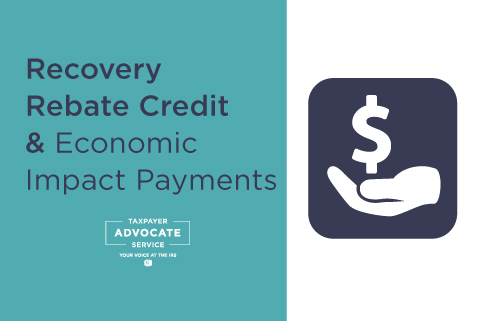

Economic Impact Payments (EIPs), also known as stimulus payments, and the related Recovery Rebate Credits (RRCs) are essentially divided into two tax years: 2020 and 2021. The information outlined below is to help you understand which EIPs relate to which RRC and how to find more information about each.
Please share this information: If you have friends, family or clients who do not have internet access, please feel free to print this article and share it with them. Both TAS and IRS phone lines are overloaded with calls, so taxpayers who chose to call may encounter long wait times. Help get this information out to others.
Two EIPs (EIP1 and EIP2) were issued to eligible taxpayers during 2020 and early 2021. These EIPs were advanced payments of the Recovery Rebate Credit (RRC), a refundable credit, claimed on the 2020 Individual Tax Return.
If you are eligible and did not receive either or both EIPs, you now must claim them as the RRC on the 2020 Form 1040, Individual Income Tax or Form 1040-SR, U.S. Tax Return for Seniors. The Form 1040 and Form 1040-SR instructions include a worksheet you can use to figure the amount of any RRC for which you are eligible.The eligibility criteria for the RRC is generally the same as for EIPs, except that the RRC is based on tax year 2020 information, instead of the tax year 2019 or tax year 2018 information used for EIP1 and tax year 2019 information used for EIP2.If you are not normally required to file a tax return, you still must file either a 2020 Form 1040, Individual Income Tax or Form 1040-SR, U.S. Tax Return for Seniors to get the amount owed.
There is no other way to receive the amount of 2020 stimulus/RRC credit you may be entitled to, with one exception:
If you did not receive an EIP payment, but did get Notice 1444, visit the IRS’s Economic Impact Payments page and look for the EIP Frequently Asked Questions and Answers pages; then, under the section titled Payment Issued but Lost, Stolen, Destroyed or Not Received, follow the applicable instructions. Note the EIP FAQ pages are separated for the EIP1, EIP2, and EIP3 payments, so make sure you are looking at the correct page for the EIP you are missing.
If you are eligible for a refund of your 2020 income tax, then the amount you receive for the Recovery Rebate Credit will be included as part of your 2020 tax refund. It will not be issued separately. You can check the status of your refund under Where’s My Refund?Generally, you will receive your refund within 3 weeks if you file electronically or 8 weeks if you mail your return. See How long you may have to wait? for more details. If the IRS identifies an error in your calculation for this (or anything else reported on your return), it could also cause a delay while IRS make any necessary corrections. Please note that the IRS is experiencing delays in processing mailed tax returns. To receive any tax refund you are due, we recommend you file your tax return electronically as quickly as possible. If you need assistance with electronically filing and you meet the eligibility requirements, a Volunteer Income Tax Assistance or Tax Counseling for the Elderly site may be able to assist you.Be aware though, that the 2020 Recovery Rebate Credit can be reduced to pay debts owed to other Federal government agencies (separate from federal income tax debt), as well as to state agencies. Keep in mind that the credit is part of your tax refund and your tax refund is subject to any offset. However, see the National Taxpayer Advocate’s blog, dated March 15, 2021 for more information concerning 2020 RRC offsets.
The IRS is mailing letters to some taxpayers who claimed the 2020 credit, but may be getting a different amount than they expected. Here are some common reasons the IRS corrected the credit:
See our Coronavirus (COVID-19) Tax Relief page, Recovery Rebate Credit & Economic Impact Payments section and Additional Economic Impact Payment Information section for more detailed information or go to the following IRS.gov pages:
See also TAS’s Ability to Help With Delayed Refunds Is Limited.
The American Rescue Plan Act of 2021, enacted March 11, 2021, provides a 2021 Recovery Rebate Credit (RRC) which can be claimed on 2021 Individual Income Tax Returns. It also provides for an advanced payment of the RRC in calendar year 2021 through payments that are referred to as Economic Impact Payments (EIP3), similar to what was done in 2020, but with different eligibility criteria and payment amounts. More detailed information about when and how to claim the RRC on the 2021 individual tax forms will be provided prior to the opening of the 2021 filing season.
Generally, the amount will be $1,400 (or $2,800 in the case of a joint return), plus an additional $1,400 per each qualifying dependent of the taxpayer, for all U.S. residents with adjusted gross income up to a threshold phase-out of $75,000 ($150,000 in the case of a joint return or a surviving spouse, and $112,500 in the case of a head of household), who are not a dependent of another taxpayer and have a work-eligible Social Security number (SSN). The rebate amount is phased out above certain income levels.
The IRS started issuing the EIP3 to eligible individuals in phases in March of 2021. EIP3 will be sent each week to eligible individuals throughout most of the calendar year 2021 by direct deposit, or mailed as a check, or a debit card, as the IRS continues to process tax returns. You can check your payment status in the Get My Payment tool.
See our Coronavirus (COVID-19) Tax Relief page, 2021 Recovery Rebate Credit & Economic Impact Payments sections and Additional Economic Impact Payment Information section for more detailed information or go to the following IRS.gov pages: